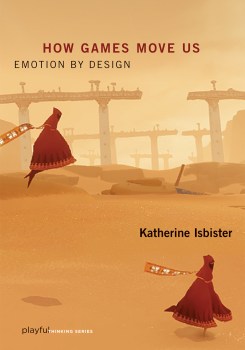‘Sackboy’ Solidarity: An Emotional Gaming Experience
Gamers playing “Little Big Planet” engage in a friendly and comical shared emotional experience.
The following is an excerpt from How Games Move Us: Emotion By Design, by Katherine Isbister.
There is something deeply satisfying and bonding about overcoming a challenging mental and physical situation with someone else, especially if it requires close coordination. If you’ve ever played team sports, or found yourself in an impromptu collaborative situation (getting a car out of a snowdrift, rescuing someone’s wind-scattered papers), then you know these feelings. Social psychologists have demonstrated that giving people opportunities for coordinated action (like asking them to lift and carry boards together) leads to greater feelings of connectedness, mutual liking, and rapport. Games can facilitate this kind of collaboration over an extended period of time, spanning hours, weeks, even years.
The Sony Playstation 3 game Little Big Planet showcases the simple pleasures of coordinated action with an elegant set of design choices. Launched in 2008, the game was in its third release, in 2014, and still going strong. Little Big Planet is a puzzle-platformer, a game genre in which player avatars solve physical puzzles in a two-dimensional world of platforms. The avatars can take a simple set of actions—running, jumping, pushing, and pulling—in a world seemingly made of fabric and paper. While the game’s look and feel resemble a child’s craft project, its sophisticated physics engine makes objects behave more realistically than in other platformer games (e.g., an object sliding down a hill will gain speed until it collides with something or the slope changes).
Players build avatars from a simple base body referred to as “Sackboy,” decorating these simple bodies with costuming elements and “stickers.” In an unusual twist, Little Big Planet lets players puppet the avatar’s face and body to convey emotions. Players can adjust the character’s happiness, fear, sadness, and anger using the Directional pad on the controller. Trigger buttons and tilt controls let players move, gesture, and even slap other players’ avatars.
The avatar customization tools and expression controls make these characters feel like handcrafted puppets that the player is both operating and inhabiting in the game world. Unlike the Sims, sack creatures never speak—they express themselves only through their broad body language and facial expressions (not unlike comic silent film actors). The game’s physics allow for physical antics and complex physical puzzle solving that make the avatars feel expressive and realistic to players despite their simplified bodies.

How Games Move Us: Emotion By Design
Little Big Planet encourages social play by design. The game can handle up to four players, either local (i.e., everyone is in the same room, watching the same screen) or online (connected from different locales and screens through the Sony PlayStation network). Some of the puzzles in every level can only be solved through the cooperation of two or more players.
Players solve puzzles physically (and through side conversation if they are in the same room), figuring out whose avatar needs to stand where, or press on what, in order to solve the problem. Players can use the avatars’ ready emoting to give one another silent commentary on how things are going, and can physically ham up victory and defeat.
As one writer describes his play experience:
Helen calls them the “Hurrah!” buttons. L2 + R2 + both analog sticks held upwards. Whenever she wins the most points on a Little Big Planet level, she presses these buttons, and her grinning Sackgirl lifts both arms in the air in wordless celebration. My Sackboy, meanwhile, tends to scowl and storm off the side of the screen, fists clenched. Or, after a particularly stressful level, he might pull out a frying pan and hit Helen’s Sackgirl over the head. Helen tends to take losing slightly better. She will drag my Sackboy away from the camera, mid-disco dance, in a vain attempt to take the spotlight. Either way, nigh every level ends in a comical scuffle between our characters without a word spoken between us in the real world.
This same writer notes that the controls in Little Big Planet allow for rich nonverbal communication between players, immersing them more thoroughly into their characters and the game world: “Instead of Helen telling me to ‘go over there,’ and pointing at a corner of the television screen, Helen’s Sackgirl herself points at a switch within the world and my Sackboy goes there. When he finds the wrong switch, Sackgirl shakes her head angrily and points again. This time my Sackboy gets it right, and Sackgirl grins and gives a thumb up.”
The original game shipped with many wildly creative pre-built levels, but the enduring popularity and power of the game derives from the ability to make and share custom levels, including avatar designs. A simple in-game movie showing a player creating a “Sackzilla” and “terrorizing” a city before being defeated by other players shows the range of character styles and emotions that players can put together to create compelling and entertaining scenarios. Anyone can easily download player-created levels and invite others to play. For further customization, Little Big Planet, like The Sims, offers popular content packs with avatar accessories and costumes ranging from pirates to historical figures to Norse gods.
Little Big Planet’s design choices—simple and emotionally puppeteer-able avatars, interesting physics, limited group size, puzzles that require teamwork—create a fun form of coordinated action. These choices also set the emotional tone by delimiting which actions are possible. Simple, comical avatars with controls that make physical antics and comedic interaction easy help lead players into a friendly and silly shared emotional experience as they work together.
Adapted from How Games Move Us: Emotion by Design by Katherine Isbister, copyright © 2016 by Katherine Isbister Published by MIT Press. All rights reserved.
Katherine Isbister is a professor of Computational Media at the University of California, Santa Cruz. She is also the author of How Games Move Us: Emotion by Design (MIT Press, 2016).